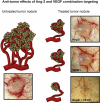Targeting the Angiopoietin-2/Tie-2 axis in conjunction with VEGF signal interference
- PMID: 25312939
- PMCID: PMC4394020
- DOI: 10.1016/j.canlet.2014.09.035
Targeting the Angiopoietin-2/Tie-2 axis in conjunction with VEGF signal interference
Abstract
Anti-angiogenic therapies target the tumor vasculature, impairing its development and growth. It was hypothesized over 40 years ago by the late Judah Folkman and Julie Denekamp that depriving a tumor of oxygen and nutrients, by targeting the tumor vasculature, could have therapeutic benefits. Identification of growth factors and signaling pathways important in angiogenesis subsequently led to the development of a series of anti-angiogenic agents that over the past decade have become part of the standard of care in several disease settings. Unfortunately not all patients respond to the currently available anti-angiogenic therapies while others become resistant to these agents following prolonged exposure. Identification of new pathways that may drive angiogenesis led to the development of second-generation anti-angiogenic agents such as those targeting the Ang-2/Tie2 axis. Recently, it has become clear that combination of first and second generation agents targeting the blood vessel network can lead to outcomes superior to those using either agent alone. The present review focuses on the current status of VEGF and Ang-2 targeted agents and the potential utility of using them in combination to impair tumor angiogenesis.
Keywords: Ang-2 targeting; Angiogenesis; Anti-angiogenic therapy; Combination therapy; VEGF targeting.
Copyright © 2014 Elsevier Ireland Ltd. All rights reserved.
Figures




Similar articles
-
Targeting angiopoietin-2 signaling in cancer therapy.Expert Opin Investig Drugs. 2013 Jul;22(7):813-25. doi: 10.1517/13543784.2013.793306. Epub 2013 Apr 27. Expert Opin Investig Drugs. 2013. PMID: 23621441 Review.
-
Angiopoietin inhibitors: A review on targeting tumor angiogenesis.Eur J Pharmacol. 2021 May 15;899:174021. doi: 10.1016/j.ejphar.2021.174021. Epub 2021 Mar 16. Eur J Pharmacol. 2021. PMID: 33741382 Review.
-
[Tumor angiogenesis: new approaches to cancer therapy].Onkologie. 2001 Feb;24 Suppl 1:1-5. doi: 10.1159/000055156. Onkologie. 2001. PMID: 11441305 German.
-
Targeting the angiopoietin/Tie2 pathway: cutting tumor vessels with a double-edged sword?J Clin Oncol. 2012 Feb 1;30(4):441-4. doi: 10.1200/JCO.2011.38.7621. Epub 2011 Dec 19. J Clin Oncol. 2012. PMID: 22184396 Review. No abstract available.
-
Efficacy of a Bispecific Antibody Co-Targeting VEGFA and Ang-2 in Combination with Chemotherapy in a Chemoresistant Colorectal Carcinoma Xenograft Model.Molecules. 2019 Aug 7;24(16):2865. doi: 10.3390/molecules24162865. Molecules. 2019. PMID: 31394786 Free PMC article.
Cited by
-
Role of the angiopoietin/Tie system in pregnancy (Review).Exp Ther Med. 2015 Apr;9(4):1091-1096. doi: 10.3892/etm.2015.2280. Epub 2015 Feb 9. Exp Ther Med. 2015. PMID: 25780392 Free PMC article.
-
Prognostic role of plasma level of angiopoietin-1, angiopoietin-2, and vascular endothelial growth factor in hepatocellular carcinoma.World J Gastroenterol. 2021 Jul 21;27(27):4453-4467. doi: 10.3748/wjg.v27.i27.4453. World J Gastroenterol. 2021. PMID: 34366616 Free PMC article.
-
Anlotinib suppresses metastasis and multidrug resistance via dual blockade of MET/ABCB1 in colorectal carcinoma cells.J Cancer. 2021 Feb 16;12(7):2092-2104. doi: 10.7150/jca.45618. eCollection 2021. J Cancer. 2021. PMID: 33754008 Free PMC article.
-
miR-15a/-16 Inhibit Angiogenesis by Targeting the Tie2 Coding Sequence: Therapeutic Potential of a miR-15a/16 Decoy System in Limb Ischemia.Mol Ther Nucleic Acids. 2019 Sep 6;17:49-62. doi: 10.1016/j.omtn.2019.05.002. Epub 2019 May 17. Mol Ther Nucleic Acids. 2019. PMID: 31220779 Free PMC article.
-
Linalool inhibits the angiogenic activity of endothelial cells by downregulating intracellular ATP levels and activating TRPM8.Angiogenesis. 2021 Aug;24(3):613-630. doi: 10.1007/s10456-021-09772-y. Epub 2021 Mar 2. Angiogenesis. 2021. PMID: 33655414 Free PMC article.
References
-
- Papetti M, Herman IM. Mechanisms of normal and tumor-derived angiogenesis. Am. J. Physiol. Cell Physiol. 2002;282:C947–C970. - PubMed
-
- Folkman J. Angiogenesis: an organizing principle for drug discovery? Nat. Rev. Drug Discov. 2007;6:273–286. - PubMed
-
- Folkman J. Tumor angiogenesis: therapeutic implications. N. Engl. J. Med. 1971;285:1182–1186. - PubMed
-
- Denekamp J. Vascular endothelium as the vulnerable element in tumours. Acta Radiol. 1984;23:217–225. - PubMed
Publication types
MeSH terms
Substances
Grants and funding
LinkOut - more resources
Full Text Sources
Other Literature Sources
Miscellaneous

